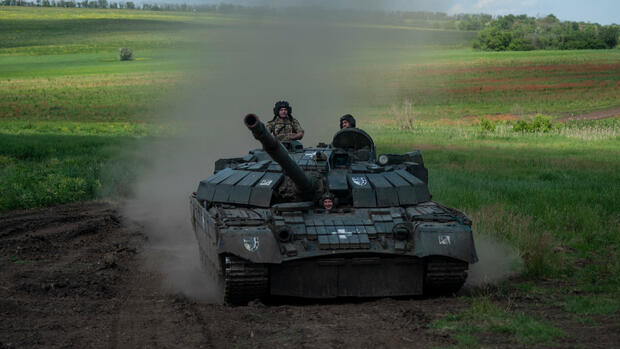The Ukrainian army is consuming more and more fuel from Russia.
(Photo: dpa)
Warsaw It is a paradox of war: the tanks from Ukraine are increasingly running on oil that comes from Russia. According to the Ukrainian customs authority, Ukraine is importing more and more diesel from Hungary and Turkey – both countries process oil from Russia in their refineries to a large extent.
Although the market position of the Hungarian MOL Group and the Turkish suppliers in Ukraine was relatively good in the past, Ukrainian customs authorities only recently reported a noticeable increase in imports. The mineral oil company MOL, which is closely linked to the Hungarian state, doubled its sales to the Ukraine in the past six months.
>> Read also: Russia is selling oil above the EU price limit again for the first time
Since MOL sources a large proportion of Russian oil, Ukraine’s war machine should now be primarily fueled with it. At the same time, companies that do not source their raw materials from Russia are losing market share in Ukraine. Because MOL has a competitive advantage over other European oil companies. The Hungarian group has a special permit from the European Union to continue supplying its refineries with Russian oil.
While Hungary’s special role has so far received little public attention, Turkey has long made no secret of the fact that it benefits greatly from oil imports from Russia.
Rail instead of pipelines Backbone of the oil supply
In principle, tanks can be refueled with different petroleum products. “Military engines are generally versatile and very tolerant of fuels,” says Polish military expert Damian Ratka.
In order to secure the energy supply for the critical infrastructure, numerous mobile diesel generators were put into operation in the Ukraine.
(Photo: IMAGO/Ukrinform)
The attacked country is almost entirely dependent on importing fuel. However, there is hardly any shortage in the Ukraine, even if the Russian attacks on the energy supply have left their mark.
For example, last winter in particular, the West provided the country with numerous mobile diesel generators to reliably supply hospitals and other public facilities with energy. Because a decentralized supply is more crisis-proof than large electricity and thermal power plants, which can be paralyzed relatively easily by rocket fire.
Nevertheless, a sufficient supply of diesel fuel is guaranteed, since many companies in the war economy have throttled their operations or are out of action altogether. Experts estimate that consumption of petroleum products could have fallen by 40 to 50 percent, despite the army’s enormous needs.
This is also confirmed by the director of the Kiev advisory group “A-95” Sergiy Kuyun. He speaks of the fact that the energy supply is currently “particularly well positioned”. The reason for this is that Ukraine has gained a large number of new delivery routes since the beginning of the war.
>> Read also: What is currently influencing heating oil prices?
“Fuel deliveries are mainly made by rail via Poland,” says Michal Paszkowski, an analyst at the Institute of Central Europe (IEŚ). “The fuel comes into the country from Slovakia and Hungary by pipeline, from Romania the diesel is first shipped and then transported by rail to the Ukraine.”
Before the Russian invasion, Ukraine had only one refinery out of six. The last Ukrainian refinery in Krzemienczuk, which, according to the company, covered around 30 percent of Ukraine’s fuel needs before the war, was considered inefficient and mainly processed domestic oil and imports from Azerbaijan.
In April 2022, however, the plant was severely damaged in a Russian bomb attack. The refinery is currently back in operation in a very limited form.
More: The ruble falls and falls – Now Russia is threatened with inflation.
